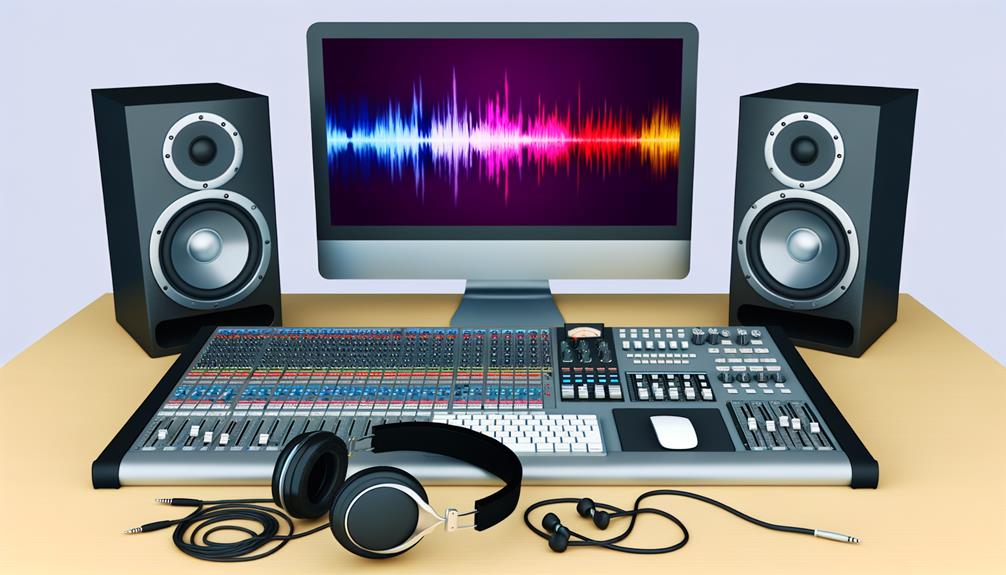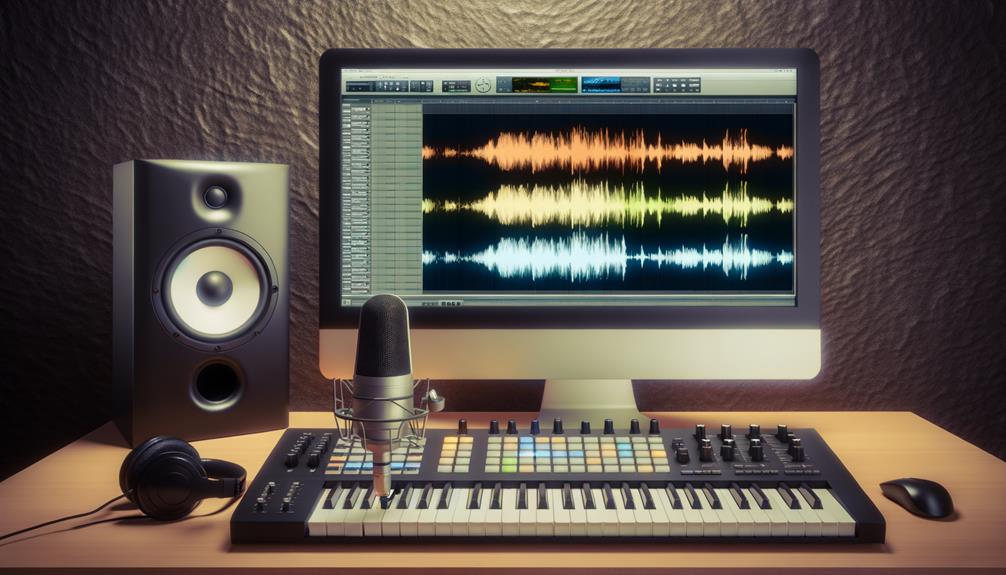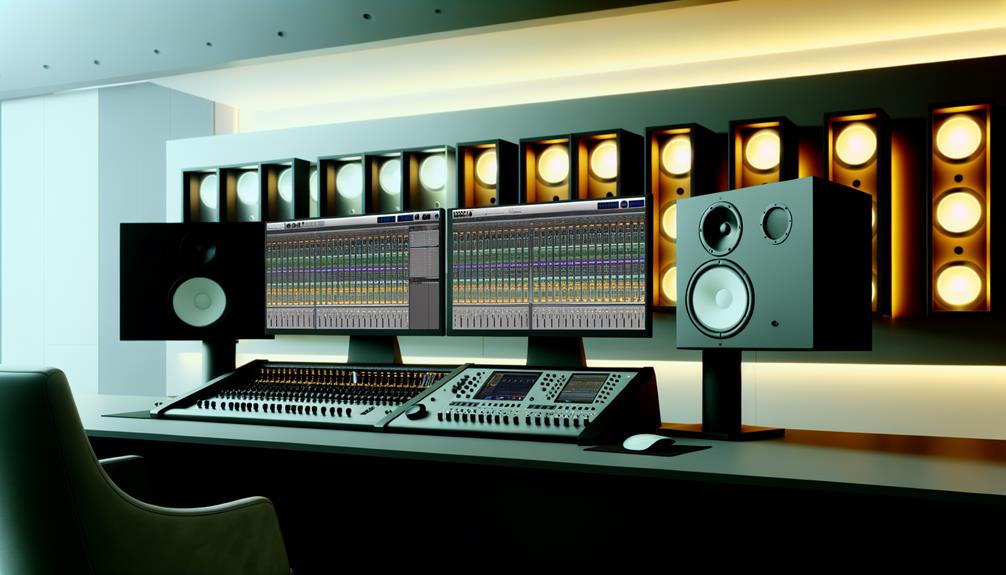No products in the cart.
Starting your audio editing journey? You’ll love these budget-friendly software picks, ideal if you’re a beginner. Consider Audacity and GarageBand—they’re free, user-friendly, and come loaded with essential tools for basic editing. If you’re using a Mac, GarageBand is especially compatible. For more thorough mastering, LANDR and CloudBounce offer affordable, subscription-based services that don’t skimp on quality. Studio One and Reaper present more extensive features while keeping costs low, supported by vibrant online communities for extra guidance. Each software balances functionality with simplicity, ensuring you’ll find the right fit for your audio projects. Let’s explore these options to find your best match.
Key Takeaways
- Audacity offers comprehensive editing tools and a supportive community, ideal for beginners.
- GarageBand is user-friendly and compatible with Mac devices, offering built-in sounds.
- Ocenaudio provides basic audio editing capabilities at no cost.
- Cakewalk by BandLab is a free DAW with advanced features, suitable for budget-conscious users.
- Reaper features extensive customization and an affordable pricing model with a trial period.
Affordable Mastering Basics
Mastering your audio tracks efficiently and affordably is now possible with tools like LANDR, Aria Mastering, and CloudBounce, which provide essential features such as EQ, compression, and limiting. These platforms are designed with the beginner in mind, offering straightforward interfaces and tutorials that guide you through the mastering process. You’ll find that applying these mastering techniques not only enhances the audio quality but also brings your tracks up to industry standards.
These cost-effective solutions are ideal if you’re looking to achieve professional-sounding results without the hefty price tag associated with traditional studio mastering. With options like subscription-based pricing or pay-per-track services, you can choose a plan that fits your budget and project needs. This flexibility means you don’t have to commit to expensive packages before you’re ready.
Moreover, these tools equip you with the ability to apply advanced audio processing features like loudness normalization and stereo widening. Such features are essential for ensuring your music competes favorably in the commercial market, all while maintaining the integrity of your original mix. Explore these user-friendly platforms and start mastering your tracks with confidence and precision.
Choosing Your First Software
When selecting your first audio editing software, you’ll need to assess your specific needs and the scope of your projects. Compare the features of different tools, focusing on user-friendliness and the availability of essential editing functions that’ll meet your immediate requirements.
Consider the cost, not just regarding the purchase price, but also in relation to potential upgrades and the necessity for additional hardware.
Assessing Your Needs
Before choosing your first audio editing software, assess your specific needs and budget to guarantee a suitable match. Consider what you’re aiming to accomplish. Are you mixing tracks, editing podcasts, or simply refining audio clips? Start by evaluating options that are compatible with your operating system and hardware to make sure of smooth operation.
Look for software that provides beginner tutorials; these resources are invaluable as you’re learning the ropes. It’s essential to choose a user-friendly interface with essential editing tools that won’t overwhelm you. This balance between functionality and simplicity will help you master basic skills without the frustration of dealing with complex features, setting you up for success in your audio editing endeavors.
Comparing Features
Evaluate each software’s features such as track count, editing tools, and audio effects to determine which best suits your initial needs as a beginner. When doing your feature comparison, keep these beginner tips in mind:
- Interface Design: Choose software with a user-friendly interface. This simplifies learning, making it easier for you to navigate through various features.
- Tutorial Availability: Look for programs that offer detailed tutorials or guides. These resources are essential for beginners to understand the basics quickly.
- Editing Tools: Make sure the software includes essential editing capabilities like audio level adjustment and noise reduction, which are important for producing clean, professional-sounding audio.
These steps will help anchor your decision in practicality and ensure a smoother start in your audio editing journey.
Cost Considerations
After considering the features of each software, it’s important to look at their costs to make a budget-conscious choice that suits your needs as a beginner.
Audacity, a free, open-source platform, offers extensive beginner tutorials and a supportive online community, making it a top pick for those on a tight budget.
GarageBand, exclusive to Apple users, provides a seamless software compatibility with Mac devices, and its array of built-in sounds and loops are ideal for starting out without additional costs.
Alternatively, Ocenaudio is another cost-free option that, while simpler, effectively meets basic editing needs.
Always consider exploring free trials of paid software to find the best fit for your budget and compatibility requirements.
Essential Features Overview
As you explore cost-effective audio software, it’s important to take into account the core functionalities that will enhance your production skills.
Make sure the software you choose includes key audio editing tools, a user-friendly interface, and access to ongoing support and updates.
These elements are essential for both ease of use and future growth in your audio projects.
Key Audio Editing Tools
To start editing audio effectively, beginners should focus on mastering essential tools such as cutting, trimming, and adjusting audio levels. These skills are foundational for producing clean, clear audio tracks.
Here are three critical aspects you’ll need to grasp early on:
- Audio Effects: Understanding basic effects like reverb, echo, and equalization is important. They can transform flat audio into something dynamic and engaging.
- Mixing Techniques: Learning to mix tracks effectively guarantees that all audio elements blend smoothly. This is essential for achieving professional-sounding results.
- Noise Reduction: Tools that help reduce noise and remove background sounds are crucial for enhancing the clarity of your recordings.
Mastering these tools will greatly improve your audio editing capabilities.
User-Friendly Interface Essentials
Using your audio editing software should be straightforward, with a user-friendly interface that includes intuitive exploration, clear icons, and easily accessible tools essential for beginners. Look for intuitive design features like drag-and-drop functionality, which simplifies your workflow. To help you master the basics, beginner tutorials should be interactive and easy to follow.
| Feature | Benefit |
|---|---|
| Color-coded tracks | Quickly identify different sounds |
| Visual timelines | Understand timing and sequence |
| Simple waveform displays | Easily see audio patterns |
These elements not only make the learning process smoother but also make sure that you’re not overwhelmed as you start your audio editing journey.
Support and Updates Access
Accessing support and consistent software updates is essential for enhancing your experience and skill as a beginner in audio editing. As you navigate through the domains of audio production, consider these key resources that budget-friendly software may offer:
- Customer Service and Troubleshooting Guides: Immediate access to help desks and detailed troubleshooting guides can swiftly resolve any technical issues you encounter, ensuring minimal disruption in your creative process.
- Regular Software Updates: These updates fix bugs, enhance performance, and introduce innovative features that keep your software aligned with current audio editing standards.
- Educational Resources: Extensive video tutorials and user manuals are invaluable for mastering the software tools, providing you with step-by-step instructions and practical tips to improve your audio projects.
Top Free Mastering Plugins
Discover how free mastering plugins like TDR Nova and Limiter No6 equip you with professional-grade tools to enhance your audio projects.
TDR Nova shines as a dynamic equalizer, offering you up to four parametric bands. This means you can apply dynamic EQ techniques precisely, controlling the frequency spectrum of your tracks with agility. It’s ideal for tackling issues that static EQs can’t handle, adjusting only when specific frequency thresholds are exceeded. This capability greatly boosts your mastering workflow efficiency, ensuring you’re not constantly tweaking settings that don’t need adjustment.
Limiter No6 provides robust peak and RMS limiting functionalities, which are essential for preventing digital clipping while maintaining the overall loudness of your track. With its high-quality oversampling feature, you’re assured that the sound quality isn’t compromised, even at higher drive settings. The advanced dithering options help you to finalize your tracks without losing audio fidelity during the conversion process. By incorporating these tools, you’ll see a marked improvement in the sonic quality of your projects, making your tracks ready for public consumption or further professional processing.
User-Friendly Interfaces
While mastering plugins like TDR Nova and Limiter No6 enhance your audio’s technical quality, user-friendly interfaces in software make these tools accessible and manageable for beginners. As you immerse yourself in the world of audio editing, you’ll find that the ease of moving through a complex software environment can greatly flatten your learning curve.
- Simplified Layouts: Software offering clear icons and straightforward controls allows you to grasp basic functions quickly. You won’t be overwhelmed by excessive options, making your initial steps into audio editing less intimidating.
- Customizable Workspaces: With customizable layouts, you can organize your workspace to suit your specific editing style. Whether you prefer having all your tools in one toolbar or spreading them out across multiple screens, these flexible interfaces let you tailor your environment to your comfort.
- Interactive Tutorials: Many audio editing software now include interactive tutorials that guide you through tasks step-by-step. These are invaluable for you to understand complex processes and apply what you’ve learned directly in real-time.
User-friendly interfaces are essential in bridging the gap between novice enthusiasm and professional competence. They ensure you’re not just using the software, but also mastering it, paving the way for more advanced explorations in audio production.
Mastering Software Reviews
Exploring various mastering software options, you’ll find that tools like iZotope Ozone Elements provide essential features for beginners at an affordable price. This software simplifies complex audio mastering techniques into a user-friendly interface that’s easy on the wallet. It’s a prime example of budget-friendly mastering solutions that don’t skimp on quality.
LANDR offers a different twist with its AI-powered mastering. It’s perfect if you’re looking for quick, automatic enhancements without diving deep into the technicalities. Meanwhile, T-RackS 5 One appeals to those interested in classic, analog-modeled tools, enabling you to achieve professional-sounding results even if you’re just starting out.
CloudBounce and Waves offer unique propositions too. CloudBounce provides automated mastering with adjustable parameters tailored to different genres, making it highly versatile. Waves’ Abbey Road Studio 3 plugin, on the other hand, simulates the famous studio’s acoustics, offering a unique environment for making critical mastering decisions.
Here’s a quick comparison to help you decide:
| Software | Features | Best For |
|---|---|---|
| iZotope Ozone | User-friendly, affordable | Beginners needing inclusive tools |
| LANDR | AI-powered, quick results | Beginners preferring automatic mastering |
| T-RackS 5 One | Analog-modeled, professional feel | Beginners looking for classic sound |
Choose wisely to make sure your tracks sound polished and professional!
Best Practices for Beginners
Start by downloading free software such as Audacity or GarageBand to grasp the basics of audio editing. These platforms aren’t only cost-effective but also packed with essential features that will help you understand the fundamentals of sound quality and audio optimization.
Here’s how you can improve your skills and enrich your audio editing journey:
- Experiment Vigorously: Don’t hesitate to try different effects and tools available in your software. Adjusting levels, applying compression, and experimenting with equalization are vital for enhancing audio quality. Each project will teach you more about the nuances of audio work.
- Seek Community Advice: Engage with online forums and communities related to audio editing. Here, you can ask for feedback, learn from the experiences of others, and find out about new techniques and trends in audio optimization.
- Consistent Practice: Regular practice is key. Try to edit different types of audio clips to handle various scenarios. This won’t only build your confidence but also deepen your understanding of how to maintain high sound quality across different projects.
Advanced Tools in Budget Software
After mastering the basics with free tools like Audacity, you’ll find that these software options also include advanced features to further enhance your audio projects. Despite its label as a beginner-friendly tool, Audacity comes packed with capabilities that allow for sophisticated audio manipulation without compromising the original quality of your tracks, thanks to non-destructive editing.
This feature means you can tweak, adjust, and experiment with various settings and effects without permanently altering the original audio file. It’s invaluable as you won’t lose your initial recordings and can revert changes at any point. Advanced effects in Audacity, such as noise reduction, pitch correction, and audio restoration, are particularly useful. These tools empower you to produce clean, professional-quality audio by removing unwanted noise, correcting pitch issues, and restoring degraded audio files.
Moreover, Audacity supports multi-track editing, enabling you to manage multiple audio tracks simultaneously. This is important when you’re looking to layer sounds or balance different elements of a mix effectively. Each track can be individually adjusted, employing a range of effects and filters to achieve the desired outcome. Even on a budget, you’re equipped to handle complex audio projects with a high degree of control and creativity.
Community and Support Resources
Beyond mastering individual tools, engaging with community and support resources can greatly enhance your audio editing skills. As you explore the world of audio production, tapping into the collective knowledge and experience of others is invaluable. Here’s how you can use these resources to your advantage:
- Join Online Communities for Networking
- Participate in forums like Gearslutz, Reddit’s r/audioengineering, and KVR Audio. These platforms allow you to inquire, share experiences, and receive feedback from fellow audio enthusiasts and professionals. Networking here can lead to collaborative opportunities and mentorship.
- Follow Industry Leaders on Social Media
- Platforms like Twitter, Instagram, and YouTube are goldmines for industry insights. Follow audio experts and professionals to stay updated with the latest trends, tips, and technological advancements. This continual learning can keep you informed and inspired.
- Invest in Online Learning
- Platforms like Coursera, Udemy, or Skillshare offer courses designed for varying skill levels. These structured learning opportunities provide practical guidance and deepen your understanding of complex audio editing techniques.
Upgrading From Beginner Software
While you’ve been leveraging community insights and online learning to hone your skills, you might find that your beginner software no longer meets your growing needs in audio production. As you seek advanced functionalities, consider Studio One, which is praised for its user-friendly interface and high-quality plugins. It’s an excellent step up without breaking the bank.
Additionally, Reaper offers extensive customization options that allow you to tailor the software to your specific production style. Its affordability is notable, with a $60 license and a 60-day trial that provides full access without limitations. This makes it an ideal candidate among budget-friendly options for those ready to expand beyond basic tools.
Reason Studios’ Reason Plus could be your go-to if your work heavily involves instruments. At $20 per month, you gain access to an impressive suite of 70 instruments and effects, enhancing your production capabilities significantly.
For a completely free upgrade, Cakewalk by BandLab presents a robust DAW that integrates seamlessly with a music production social network. This platform is perfect for those who are budget-conscious but eager to explore more sophisticated projects and collaborations.
Frequently Asked Questions
What Is the Best Audio Editing Software for Beginners?
For beginners, GarageBand stands out with its intuitive design and free access for Apple users, while Audacity offers robust community support and a wealth of plug-ins for detailed feature comparison and enhancement.
What Is the Easiest Music Making Software to Use?
For ease of use in music making, GarageBand stands out due to its intuitive user interface design and workflow simplicity, making it a top choice for you to start creating music effortlessly.
What Is the Easiest DAW Software to Learn?
GarageBand’s DAW interface design simplifies your learning curve compared to others. It’s user-friendly, offering practical, detailed tutorials that help you master audio editing efficiently without overwhelming you with complex features.
What Is the Easiest Recording Studio Software?
The easiest recording studio software for you offers interface simplicity and excellent hardware compatibility. GarageBand excels here, with its intuitive controls and seamless Apple device integration, making your audio production journey straightforward.
Conclusion
Now that you’ve explored the best budget-friendly software for starting your audio journey, it’s time to immerse yourself. Choose a tool that matches your needs, and don’t overlook the power of free plugins to enhance your projects.
Engage with online communities for extra support and tips. As you grow more confident, consider upgrading to more advanced software to expand your capabilities. Remember, the right tools and a commitment to learning can dramatically elevate your audio mastering skills.




